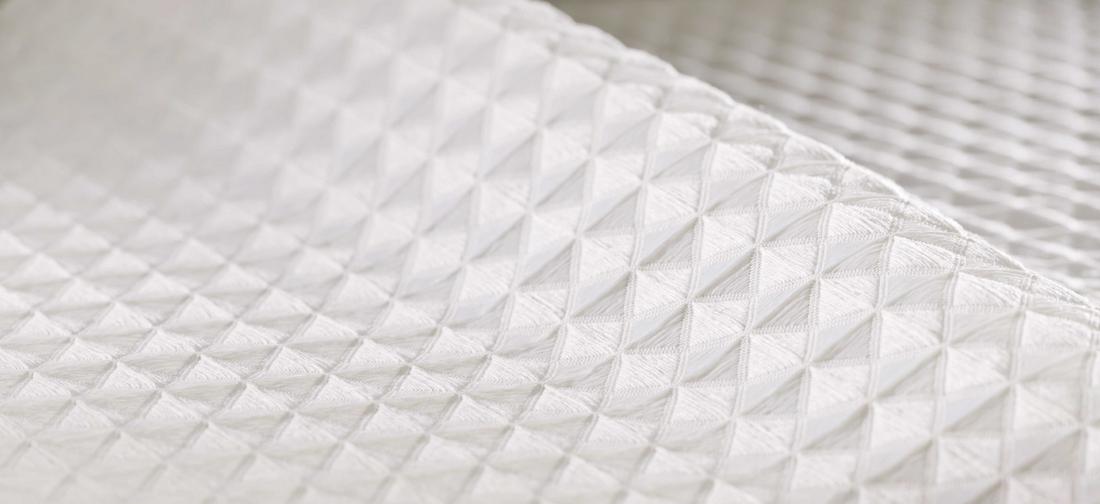
The Science Behind Sound Absorption in Textiles
Share
Understanding how sound absorption works in textiles is essential for professionals designing interiors that balance aesthetics with acoustic functionality. From bustling offices to serene concert halls, sound control has become a fundamental aspect of creating comfortable, effective spaces. Acunic, a leader in innovative acoustic solutions, is transforming how architects, interior designers, textile wholesalers, and acoustic consultants approach sound management. This article dives into the science behind sound absorption in textiles, examining their materials, design, and application.
What is Sound Absorption?
Sound absorption refers to the process of reducing sound energy as it passes through or reflects off materials. Unlike soundproofing, which blocks sound transmission, absorption minimises echo and reverberation within a space. Textiles, particularly when engineered for acoustic purposes, are ideal for this function because of their porous structures, which dissipate sound energy as heat.
When sound waves encounter a textile surface, part of the wave is absorbed into the fabric, while the rest is either reflected or transmitted. For architects and designers, understanding how textiles interact with sound enables the creation of harmonious environments that support productivity, relaxation, and communication.
How Textiles Absorb Sound
The science of sound absorption in textiles is closely tied to material properties, weave patterns, and installation techniques. Three primary mechanisms drive sound absorption in textiles:
- Porosity: Porous materials, like woven or non-woven fabrics, allow sound waves to penetrate the material. The energy is then dissipated within the fibrous structure, reducing the intensity of the reflected sound.
- Surface Texture: The texture of a textile affects how it scatters sound. Uneven surfaces or layered materials increase absorption by trapping sound waves within the layers.
- Density and Thickness: Thicker and denser textiles can absorb lower-frequency sounds, which tend to carry more energy.
Acunic’s acoustic textiles, for instance, utilise advanced polywoven 3D technology to maximise these properties, achieving sound absorption levels of up to 90%.
Key Properties of Acoustic Textiles
For textiles to effectively absorb sound, they must possess specific physical and chemical properties. The following factors determine the acoustic performance of a fabric:
- Fiber Composition: Fibers such as Trevira CS or polyester are commonly used in acoustic textiles for their durability and adaptability. Trevira CS, featured in Acunic’s products, is flame-resistant and supports intricate weaving techniques for optimal sound absorption.
- Fabric Weight: Heavier fabrics with higher GSM (grams per square meter) often absorb more sound. However, lightweight materials with specialised structures can also perform exceptionally well.
- Weave Density: Loosely woven fabrics allow sound waves to penetrate deeper, enhancing absorption. Tight weaves, on the other hand, are better suited for blocking higher frequencies.
- Fire Resistance: Acoustic textiles used in public or commercial spaces must meet stringent fire safety standards. Acunic’s products comply with Group 1 fire resistance standards, ensuring safety without compromising performance.
Applications of Acoustic Textiles in Modern Interiors
Acoustic textiles are a versatile solution for sound control across a range of environments. Their ability to combine functionality with aesthetics makes them a favourite among architects and interior designers. Key applications include:
- Ceiling Sails: Suspended panels absorb sound in large, open spaces, reducing echo and creating a more focused acoustic environment.
- Wall Panels: Textiles mounted on walls enhance sound clarity, particularly in offices, lecture halls, and theaters.
- Curtains and Dividers: Acoustic curtains provide flexible sound management and can be customised to fit any design. Movable partitions are especially valuable in multipurpose spaces.
Acunic offers fully customisable acoustic solutions, allowing professionals to tailor colours, patterns, and installation methods to their specific projects.
The Role of Colour in Acoustic Performance
A common misconception is that dyeing or printing fabrics can alter their acoustic properties. However, Acunic’s advanced manufacturing processes ensure that performance remains consistent, regardless of the chosen colour or design. This enables designers to experiment with vibrant palettes and unique patterns without sacrificing sound absorption.
Custom UV printing is also available, making it possible to integrate logos, artwork, or patterns directly onto the acoustic textiles. This innovation bridges the gap between acoustic functionality and creative freedom.
The Future of Acoustic Textiles: Innovations by Acunic
Acunic is setting new standards in the field of acoustic textiles by leveraging cutting-edge technology and research. Their polywoven 3D fabrics, engineered for maximum sound absorption, combine scientific precision with artistic versatility. Acunic’s commitment to sustainability further enhances its appeal, as its products are free from VOCs (volatile organic compounds) and allergens.
For architects and interior designers, these features translate into healthier, more sustainable spaces that support well-being without compromising on style or safety.
Benefits of Acoustic Textiles for Architects and Designers
- Enhanced Comfort: Reduced noise levels improve focus, reduce stress, and enhance the user experience.
- Design Flexibility: Customisation options ensure seamless integration with any architectural style.
- Compliance and Safety: Meeting fire resistance and environmental standards provides peace of mind in commercial applications.
- Ease of Installation: Acunic’s professional installation services guarantee a flawless finish and long-lasting performance.
Why Choose Acunic for Acoustic Solutions?
Acunic, a premium brand by Getzner Textil, brings over 200 years of textile innovation to the field of acoustics. Their products are meticulously designed to offer superior sound absorption, unmatched aesthetic quality, and long-term durability. With a global reputation for excellence, Acunic is trusted by industry leaders across Australia, New Zealand, and Asia.
From mass-production capabilities to bespoke solutions, Acunic empowers professionals to create soundscapes that inspire and transform.
FAQs
What makes a textile acoustic?
Acoustic textiles are engineered with porous or fibrous structures that absorb sound waves, reducing echo and reverberation.
Can acoustic textiles be customised for color and design?
Yes, Acunic offers extensive customisation options, including colour matching and UV printing, without compromising acoustic performance.
Are acoustic textiles eco-friendly?
Acunic’s products are free from VOCs and allergens, making them environmentally friendly and safe for critical environments.
What types of spaces benefit from acoustic textiles?
From offices and classrooms to theaters and restaurants, any space where noise control is critical can benefit from acoustic textiles.
Do acoustic textiles meet fire safety standards?
Acunic’s textiles are Group 1 & 2 fire-resistant and comply with stringent safety regulations, ensuring safe use in commercial and public spaces.
How effective are Acunic’s textiles in reducing noise?
Acunic’s products achieve up to 90% noise reduction, providing unparalleled sound absorption for a variety of applications.
Conclusion
The science behind sound absorption in textiles has opened new possibilities for creating functional and aesthetically pleasing interiors. Acunic’s innovative approach to acoustic textiles is revolutionising sound management, enabling architects, interior designers, and acousticians to craft spaces that are as beautiful as they are effective.
By blending cutting-edge technology with customisable design, Acunic ensures that every project—big or small—achieves optimal acoustic performance. To explore the endless potential of acoustic textiles, visit Acunic today.
